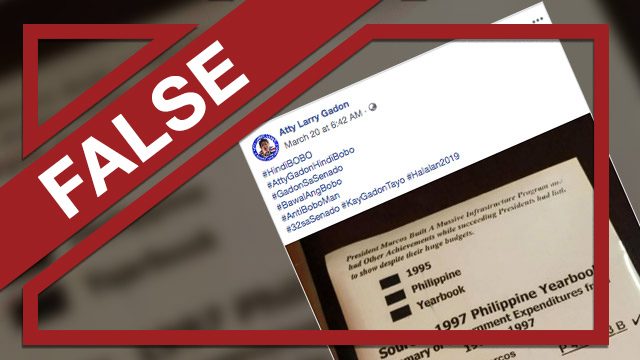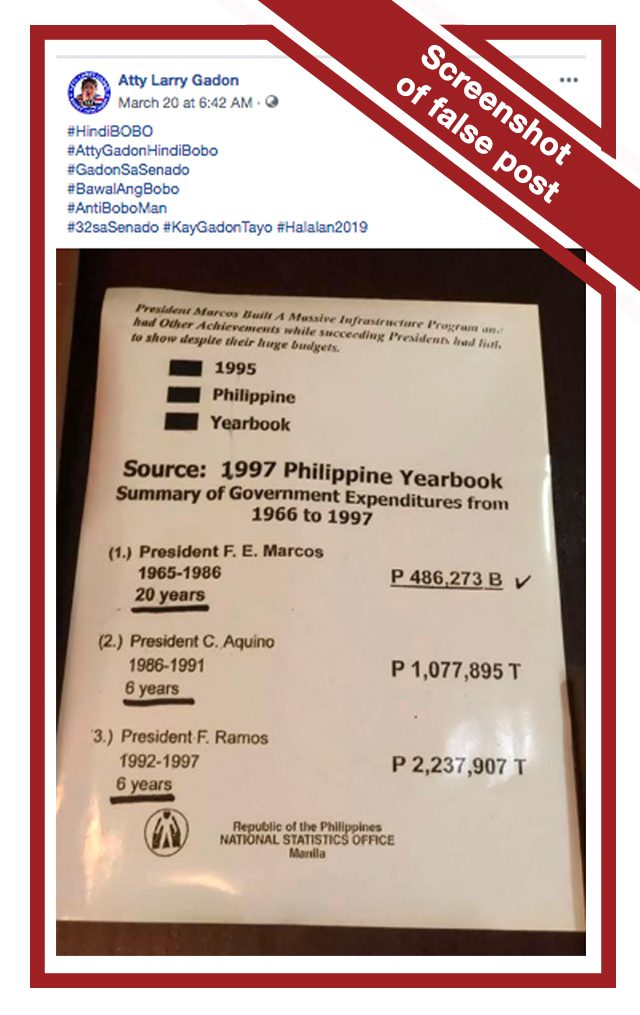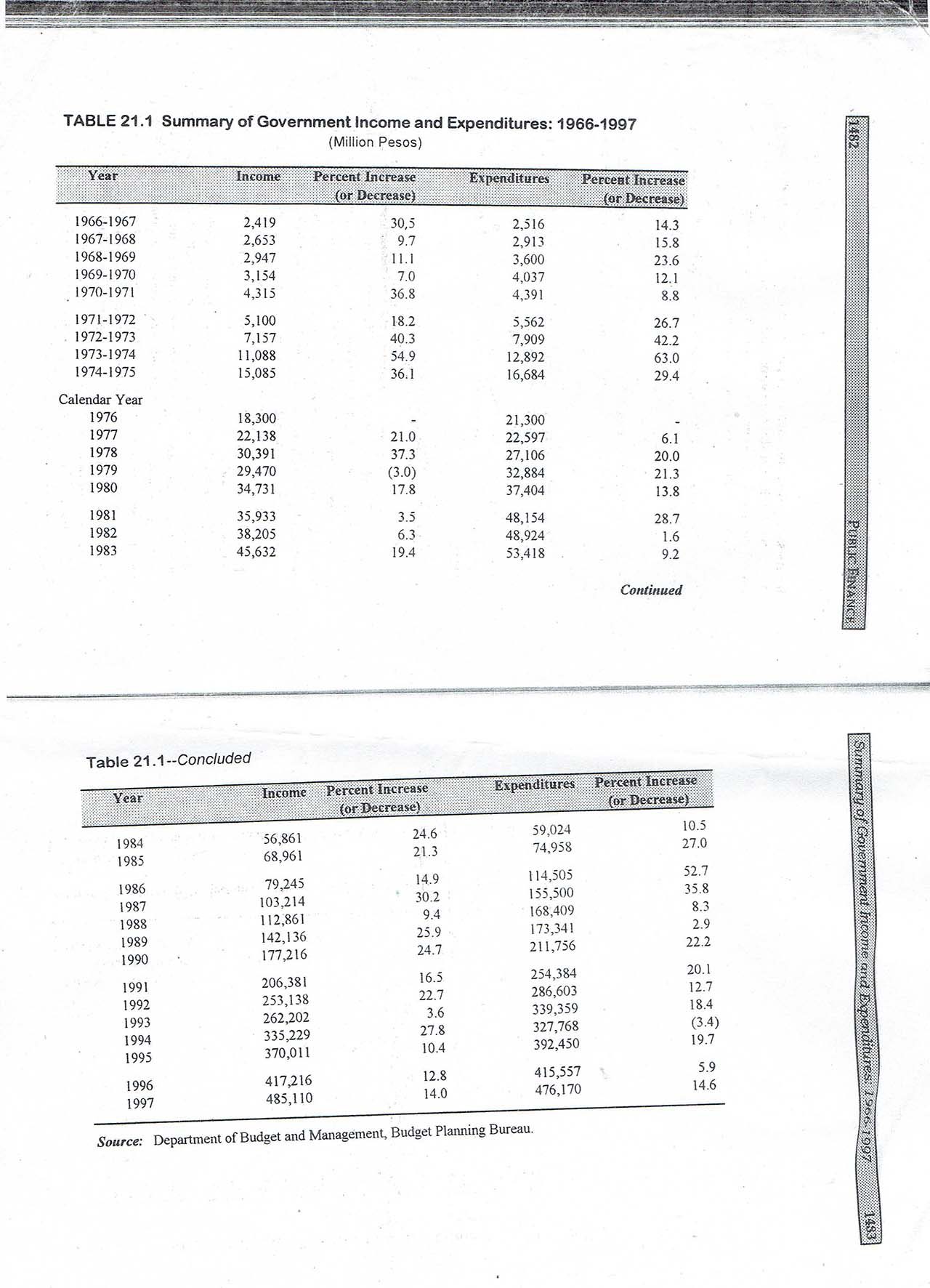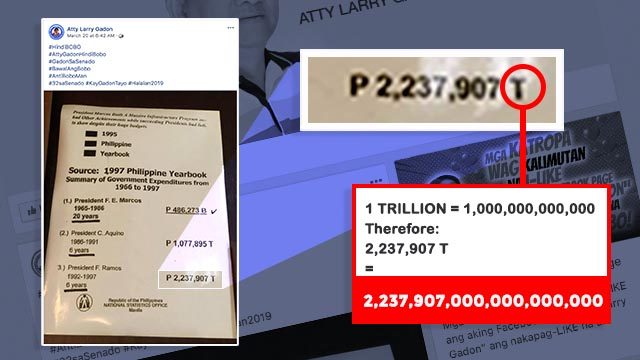SUMMARY
This is AI generated summarization, which may have errors. For context, always refer to the full article.

CLAIM: Data, contained in a one-page summary of Philippine government expenditures from 1966 to 1996, was allegedly sourced from the National Statistics Office (NSO).
The official Facebook page of senatorial candidate Larry Gadon posted a photo showing a list of figures of supposed government expenditures under the administration of 3 former presidents: Ferdinand Marcos, Corazon Aquino, and Fidel Ramos.

Marcos supposedly spent only “P486,273 billion” from 1965 to 1986 (or in 21 years). In comparison, Corazon Aquino supposedly spent “P1,077,895 T (trillion),” while Fidel Ramos spent “P2,237,907 T.”
The figures were allegedly sourced from the 1997 Philippine Yearbook released by the NSO.
With that amount, the image indicates, “President Marcos built a massive infrastructure program and had other achievements while succeeding presidents had little to show despite their huge budgets.”
As of posting, Gadon’s post has generated almost 22,000 interactions. The claim was spotted via Crowdtangle with two more pages sharing the same photo with different versions of captions.
Rating: FALSE
The Facts: Gadon’s budget graphic is a comedy of errors. It incorrectly used commas and decimal places, thus erroneously inflating budget figures. Even if decimal places were correctly expressed, only the summary of expenditures for the Ramos administration can be correctly connected to the NSO figures. The rest were incorrect. Finally, the graphic also fails to account for differences in peso values across the years due to inflation, making the figures non-comparable. It’s like comparing apples to oranges.
To begin with, the NSO does not summarize government spending by presidency. What it publishes are annual expenditures. Below is the copy of the figures published by the NSO as obtained from the library of its successor, the Philippine Statistics Authority (PSA):

As shown above, the NSO figures are shown in millions.
In his graphic, Gadon did not use millions. He used B, representing billions, and T representing trillions. Using these without adjusting the decimal places in the figures erroneously increased the value of the numbers in his graphic to trillions (Marcos years) and quintillions (Aquino and Ramos years) respectively.

The table below shows how billions and trillions in Gadon’s graphic translate in actual decimal places.
Even if the decimal places were correctly reflected, only the summary figures for the Ramos administration – a total of P 2.237 trillion – can be directly connected to the NSO figures. (See table below for details per year.)
The summaries for the periods 1966 to 1986 (Marcos presidency) and 1986 to 1992 (Aquino presidency) would still be inaccurate.
If recomputed, the budget during the Marcos years becomes P600.778 billion, not P486.273 billion. (See table below for annual expenditures.)
For the Aquino years, it should be P1.364 trillion and not P1.007 trillion. (See table below for details on annual spending.)
It is also important to note that figures reflected were nominal values – not adjusted to inflation.
Jethro Anaen, technical staff of the Department of Budget and Management’s Fiscal Planning and Reforms Bureau, said that government expenditures for each administration are “not comparable as the amount in 1966 might not be the same in 1997.”
Rappler resident economist JC Punongbayan said it is important to adjust spending to inflation. “As prices rise generally over time, the spending needs [increases] in absolute terms.”
For example, P500 in 1966 will be able to buy the same amount of goods as P35,714 in 2012 – the baseline year the PSA uses to adjust spending figures across the years to make them comparable. (To understand further how this works read: What inflation means to you.)
For more details on Philippine inflation rates since the 1960s, check out our story: Philippine inflation rate over the years. – Glenda Marie Castro and Gemma B. Mendoza/Rappler.com
Keep us aware of suspicious Facebook pages, groups, accounts, websites, articles, or photos in your network by contacting us at factcheck@rappler.com. Let us battle disinformation one Fact Check at a time.
Add a comment
How does this make you feel?
There are no comments yet. Add your comment to start the conversation.